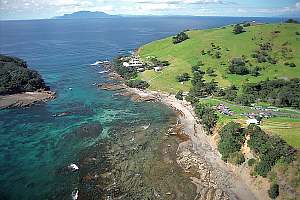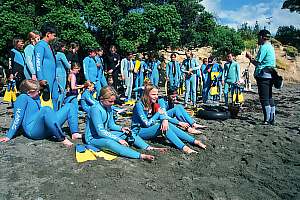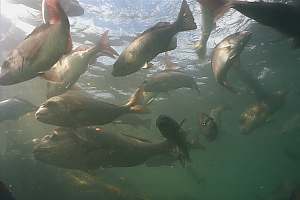 |
 |
For comments and suggestions, e-mail
the author.
-- Seafriends home -- news
index -- Rev 20051116,
But Rodney District Council mayor John Law and his planner Lloyd Barton, think otherwise: "The Council was concerned with the visual impact of a further dwelling and associated buildings within the sensitive coastal area," he writes in his letter of 7 November. And this in spite of the fact that subdivision in this area is allowed for setting aside a 2ha plot of native bush, and also an ever growing university complex, located at the very edge of the sea.
"What is the problem with setting aside a conservation and education centre instead," asks Dr Anthoni. "it is so ironical that the blind execution of the Resource Management Act kills an institution which is fighting hard to save the sea. These people (RDC) plan arbitrary zonings with arbitrary boundaries and arbitrary rules that are interpreted arbitrarily, and they think that all this is somehow REAL. And then they are happy to be tied with their hands behind their backs because of such rules. Madness has indeed replaced Common Sense"
The Seafriends centre in Leigh is visited each year by some 3000 school children for an educational day of immersion in matters of the sea. They go snorkelling in the marine reserve, view creatures on the rocky shore, receive an inspiring lecture and make discoveries in the ecosystem aquariums. Schools arrive from as far afield as Kaitaia and Taranaki and from overseas.
"Fifteen years of hard work have brought all this together," says Maria Anthoni, "My husband has worked so hard on the many educational resources and this year he has discovered how degradation in the sea really works."
Scientists are still reeling under the scientific discoveries made by Dr Anthoni in recent years as something big and important has been overlooked, as well as a method to measure it.
"With hindsight it is all very simple," he explains, "The sea does not only feed but it also kills. In the planktonic ecosystem the decomposers play an indispensable role, but these are also the nasties (bacteria, fungi and viruses) that cause infection and disease. And when the sea becomes over-fed (eutrophic), these bacteria take over. Stealing the solar energy, they change the sea from a feeder to a killer. It is now even affecting our coastal fisheries. You cannot have healthy fish stocks in sick seas."
Dr Anthoni also invented a new scientific technique to measure the activity of these decomposers and their density, in other words, the health of the sea, lakes and rivers. "The method is very exciting because it costs less than $1000, is completely portable and can be done by secondary school children," he says. "The public now has a tool to keep a finger on the pulse of the environment and everyone can join in. It is so sad to lose Seafriends when my mission is only half done, that of saving our seas."
For more information, visit the Seafriends web site www.seafriends.org.nz.
|
an article for the Term 4 2005 issue of Principals Today by Angela O Perez Reproduced by permission of A-MARK Publishing www.academy.net.nz. The Seafriends Marine Conservation and Education Centre is aimed at increasing the knowledge of school kids and the public about the problems of the sea, and producing solutions for these ecosystems. |
Despite the fact that three quarters of the world’s surface is covered by sea, Seafriends Marine Conservation and Education Centre is trying to turn the tide of Sea education in New Zealand. Established in 1990, it is an organisation devoted to increasing the knowledge and attitudes towards the sea and is committed to increasing awareness and knowledge of it in society and the government.
“Sea knowledge should be more important than learning about any of the countries on the earth” says founder of Seafriends, Dr Floor Anthoni. Having dedicated the last 20 years of his life to saving the seas, he has tried to continually research and provide information to the public regarding what really is the state of the sea. With information as the cornerstones of his website and message, the truth is that change in government policy and even public opinion are largely weighed against him. New research and information in the field has even brought in his eyes a contrast to what is dictated as proper sea treatment by the government and international authorities.
“The Sea in New Zealand was sick and getting sicker much quicker than anyone expected. Being a diver I noticed this much earlier than many others.” Experiencing the financial crash of the late 80’s, he was also inspired to do something with a larger meaning and decided to continue in the direction of his passion, researching and looking after the sea. So came the idea of setting up Seafriends Marine Conservation and Education Centre, where children could learn and be educated about the damage being done to the sea and changes necessary to improve this ecosystem. Today he says he is proud to dedicate his life entirely to saving the sea.
But while the Seafriends Centre has been established to encourage education and change in our approach to the sea, Mr Anthoni is fully aware that reaching significant numbers of schools and school children is one of the most challenging aspects of running the centre. Attracting roughly 3000 students per year and there being roughly 300,000 students in New Zealand, he worries that even numerically odds are stacked against him. Today he says the greatest interest in his website comes from United States secondary schools, with only a small 5 percent of interest for the centre coming from New Zealand.
The Seafriends website however is a highly unique resource that is highly ranked among websites. Holding up to 5000 images and almost 3000 pages of information and resources visited by over one million visitors this year, kids are likely to encounter information that is very recent and full of the latest research. “Teachings of this website provide comprehensive and reliable information.” He even believes some information provided by government agencies are unreliable and says people need to be properly informed to digest this information. But he says even if there were significant increases in the knowledge and awareness about the problems of the sea, producing solutions for these ecosystems will not be an easy matter.
independent answers will unlock problems of the sea
Even now, with his Seafriends website and Marine Conservation and Education Centre he sees no real solution to the problems of the sea. But he strongly believes educating the public and future generations is one of the most important responses to the problems faced. “We need smart children to solve some of these problems…we have this image that New Zealand is clean and green, but the fact is that we are not, we have some of the most polluted waters in the world.” He adds that New Zealand is different from Australia and the US and needs to find its own independent answers to its problems of the sea. “We can’t go copying the same mistakes of other countries; we need to find our own solutions to our own problems.”
Regarding the establishment of the Seafriends Marine Centre, he says it is unique. “It is in fact such a new idea that there is nothing like it in the world, you can look on the internet, but you won’t find it.” Speaking about the centre, he says one of the things that makes the centre different is its proximity to a body of clear water. The centre, particularly aimed at school kids, is open to the public and has an aquarium, library, restaurant and café and also a dive hire centre. He says there aren’t many places in the world where you have clear water next to a big city. Or clear water next to a population of people. “Now we still have Leigh (the location of the centre) and it is still the clearest place near Auckland.”
Talking to Mr Anthoni it becomes fully apparent the passion and dedication that he has for the sea, came as a response to the damage that he noticed back in the late 80’s. Back then he says environmental awareness and issues were just beginning to rise to public awareness and seeing the damage first hand, as an experienced diver, he was shocked by people’s obliviousness to it. “I was seeing the sea was deteriorating so quickly and at the same time nobody was noticing. That was very, very frightening.” Comparing his concern for the sea like one a mother has for their child, you can see his own sense of custodianship to the sea is very strong. “If you imagine it like having a kid and you see the child sick and deteriorating, and others can’t see it , what would you do in that situation?” This inspired him to change his whole direction in life and try to change the degradation happening. Today this interest has led him to gaining an extensive knowledge about the sea, with few people having as much background and scientific knowledge about the sea.
Regarding the public’s knowledge about the sea, he says while it has improved over the last decade, there are many perceptions that need to change. “Our understanding of the sea (through research) has increased far, far faster, but the knowledge that people have has lagging behind, and the fact the sea is being threatened, and the knowledge about this has stayed very, very far behind.” This is despite the fact he says, that New Zealand is the fourth largest sea nation in the world, just by volume alone. Conservation groups he says need to improve their knowledge so they’re all working in the interest of New Zealand waters.
Education to turn tides of pollution
Educating about the sea
But trying to clarify what the solutions are to the complex problems
of the seas, he says we need to look at how we affect the sea, and how
we can stop damaging it. Starting with the two areas where all problems
start for the sea, the land, and what we take from the sea, Mr Anthoni
says we need to place the responsibility of the sea back into the hands
of those that use it. “So that means don’t take it out of their hands,
but place it into their hands. So fisherman they will be the best conservationists
once the sea is put into their hands, likewise farmers, who then know what
their actions do to the sea will also see they can manage their farms in
a different way.” He says that only through having this knowledge and it
being widely acknowledged and accepted, will change happen.
But teaching kids is a tricky thing when it comes to a centre, and regarding this Mr Anthoni knows what kids will remember. “Anything that you teach them will be forgotten- the one thing they will never forget is passion. It’s the wow and the passion, amazement, that’s what children never forget, and I ask all my people that work for me the only thing they should take home is that you are mad and passionate about the sea, and anything we can teach them at school like that, is probably where we should go.”
So while researching the issues of the sea and making more effective channels for further education in the community and children, Mr Anthoni says the biggest message that children can learn is that they are, and New Zealand is a unique place in the world. “I think the kids should know that we are unique and our seas are unique and therefore our solutions are unique, and they should understand that we have to change our ways in order to save something they may never set foot in.”
providing clarity and information in a sea of confusion
Not being politically motivated, he sees his scholarly work as an essential base for future change. “Creating political action is difficult, but I am consoling myself that what I’ve done is what I needed to do, to feel that my work is complete and the political side can be done by many, whereas the scholarly side cannot be done by many, and what you find on the Seafriends website is a collection of information that you will not find anywhere else.” Saying it’s a ‘one-stop-shop’ website able to provide resources for school children and graduates alike, Mr Anthoni works hard at providing clarity and information through the Marine centre and website in a sea of confusion. While helping to turn the tide of pollution and improve the approach to what is three quarters of this earth’s surface.
Any enquiries about Seafriends Marine Conservation and Education Centre
please contact (09) 422 6212. www.seafriends.org.nz.
 |
 |
 |
 |
A-MARK Publishing www.academy.net.nz.
Academy publishing provides a group of business to business newspapers
giving you a targeted audience, wide reach, relevant readers and cost effective
advertising.